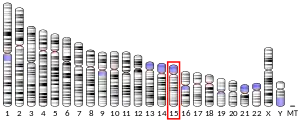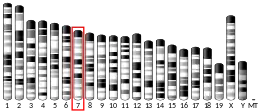Mesoderm posterior protein 2 (MESP2), also known as class C basic helix-loop-helix protein 6 (bHLHc6), is a protein that in humans is encoded by the MESP2 gene.[5]
Function
This gene encodes a member of the bHLH family of transcription factors and plays a key role in defining the rostrocaudal patterning of somites via interactions with multiple Notch signaling pathways. This gene is expressed in the anterior presomitic mesoderm and is downregulated immediately after the formation of segmented somites. This gene also plays a role in the formation of epithelial somitic mesoderm and cardiac mesoderm.[5] In zebrafish, the homolog mesp-b is critical for dermomyotome development.[6]
Clinical significance
Mutations in the MESP2 gene cause autosomal recessive Spondylocostal dysostosis type 2.[7]
References
- 1 2 3 GRCh38: Ensembl release 89: ENSG00000188095 - Ensembl, May 2017
- 1 2 3 GRCm38: Ensembl release 89: ENSMUSG00000030543 - Ensembl, May 2017
- ↑ "Human PubMed Reference:". National Center for Biotechnology Information, U.S. National Library of Medicine.
- ↑ "Mouse PubMed Reference:". National Center for Biotechnology Information, U.S. National Library of Medicine.
- 1 2 "Entrez Gene: mesoderm posterior 2 homolog (mouse)".
- ↑ Windner SE, Doris RA, Ferguson CM, Nelson AC, Valentin G, Tan H, Oates AC, Wardle FC, Devoto SH (Mar 2015). "Tbx6, Mesp-b and Ripply1 regulate the onset of skeletal myogenesis in zebrafish". Development. 142 (6): 1159–68. doi:10.1242/dev.113431. PMC 4360180. PMID 25725067.
- ↑ Cornier AS, Staehling-Hampton K, Delventhal KM, Saga Y, Caubet JF, Sasaki N, Ellard S, Young E, Ramirez N, Carlo SE, Torres J, Emans JB, Turnpenny PD, Pourquié O (Jun 2008). "Mutations in the MESP2 gene cause spondylothoracic dysostosis/Jarcho-Levin syndrome". American Journal of Human Genetics. 82 (6): 1334–41. doi:10.1016/j.ajhg.2008.04.014. PMC 2427230. PMID 18485326.
Further reading
- Whittock NV, Sparrow DB, Wouters MA, Sillence D, Ellard S, Dunwoodie SL, Turnpenny PD (Jun 2004). "Mutated MESP2 causes spondylocostal dysostosis in humans". American Journal of Human Genetics. 74 (6): 1249–54. doi:10.1086/421053. PMC 1182088. PMID 15122512.
- Morimoto M, Kiso M, Sasaki N, Saga Y (Dec 2006). "Cooperative Mesp activity is required for normal somitogenesis along the anterior-posterior axis". Developmental Biology. 300 (2): 687–98. doi:10.1016/j.ydbio.2006.08.043. PMID 16996494.
- McLellan AS, Langlands K, Kealey T (Dec 2002). "Exhaustive identification of human class II basic helix-loop-helix proteins by virtual library screening". Mechanisms of Development. 119 Suppl 1: S285-91. doi:10.1016/S0925-4773(03)00130-8. PMID 14516699. S2CID 5903576.
- Haraguchi S, Kitajima S, Takagi A, Takeda H, Inoue T, Saga Y (Oct 2001). "Transcriptional regulation of Mesp1 and Mesp2 genes: differential usage of enhancers during development". Mechanisms of Development. 108 (1–2): 59–69. doi:10.1016/S0925-4773(01)00478-6. PMID 11578861. S2CID 9238477.
- Cornier AS, Staehling-Hampton K, Delventhal KM, Saga Y, Caubet JF, Sasaki N, Ellard S, Young E, Ramirez N, Carlo SE, Torres J, Emans JB, Turnpenny PD, Pourquié O (Jun 2008). "Mutations in the MESP2 gene cause spondylothoracic dysostosis/Jarcho-Levin syndrome". American Journal of Human Genetics. 82 (6): 1334–41. doi:10.1016/j.ajhg.2008.04.014. PMC 2427230. PMID 18485326.
This article incorporates text from the United States National Library of Medicine, which is in the public domain.



